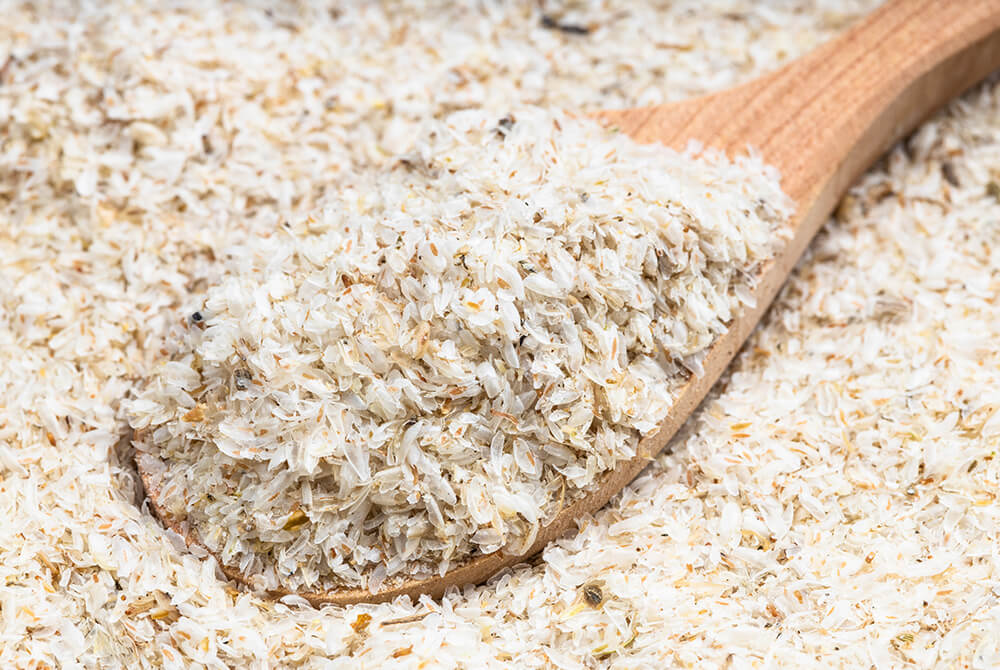Vital fibre - a natural source of soluble and insoluble fibre

Vital fibre is a mixture of psyllium and blond plantain seeds. It provides very high amounts of both soluble and insoluble fibre and is considered a natural dietary fibre supplement. How to use dietary fibre? Why is it worth it? What functions do soluble and insoluble fibre have in the body? In which products can it be found?
What is vital fibre?
Fibre is a nutrient that is important in a healthy diet and is associated with wholemeal bread or dark pasta. Vegetables are said to be rich in fibre. How about vital fibre? What is it?
Vital fibre is the name of a popular natural dietary supplement. It is a mixture of seeds and husks from two plants that are considered to be the best sources of dietary fibres. Vital fibre consists of the seeds and husks of the Psyllium plantain (Plantago psyllium) and the husks of the blond plantain (Plantago ovata). Psyllium seeds make up around 80% of the dietary fibre and Plantago ovata the remaining 20%. The seeds of the plants that make up vital fibre are similar to linseed. Both psyllium and blond plantain seeds occur naturally and can be included in the diet, but the vital fibre is called a supplement because it provides very large amounts of dietary fibre in a small volume and can be used to supplement low-fibre meals. In 100 g of vital fibre, there is 60 g of dietary fibre. In comparison, oat bran, which is an excellent source of dietary fibre, contains 7 g of fibre in 100 g of the product.
Vital fibre can be bought in practically every herbal shop, so-called health food shop, or supermarket on the shelves with BIO, EKO and "diet" products. It is also easily available in online shops. Vital fibre occurs in the form of whole seeds and ground seeds. Ground vital fibre has a shorter expiry date because the fats contained in the seeds oxidise more quickly after grinding due to the easier accessibility of air.
How to prepare vital fibre to drink?
Vital fibre is a natural fibre that is easy to include in your diet. It can be used as whole grains sprinkled into yoghurt, muesli, bread pastes or as a crunchy addition to salads. However, the most popular is vital fibre drink. How to prepare it?
For one serving of vital fibre, prepare 2-3 teaspoons of seeds and add a glass of water. Stir and leave for about 10 minutes. During this time, it will produce a characteristic infusion with the consistency of jelly or gel. Vital fibre gel alone provides soluble fibre, while drunk together with the seeds supply soluble and insoluble fibre. Vital fibre should be added to the diet gradually, starting with one serving per day and continuing with the next serving as long as the body tolerates it well, i.e. without bloating, abdominal pain, or constipation. No more than 3 portions of dietary fibre should be consumed each day. Vital fibre should be drunk approximately 30 minutes before a meal, and there should be a gap of at least 30 minutes before taking medication. Vital fibre gel can interfere with the absorption of drugs in the digestive tract.
When consuming "dry" dietary fibre remember to drink an extra portion of water - a glass for every 2-3 teaspoons. Otherwise, it is easy to lead to constipation.
Recommended products with vital fibre
Vital fibre - needs and contraindications
An adult should consume at least 25 g of dietary fibre per day. For children, the requirement depends on age, ranging from 10 g for children under 3 years to 21 g for teenagers. Vital fibre helps to supplement the diet in a simple way and to cover the body's demand for it. One teaspoon of vital fibre (5 g) contains 3 g of soluble and insoluble dietary fibre. For this reason, vital fibre can be classified as a dietary supplement. Three servings of vital fibre to drink per day completely cover the minimum requirement for fibre for an adult.
Fibre is very healthy and extremely necessary for the proper functioning of the body. However, in some conditions, it is important to be careful with its amount and limit the intake. Dietary fibre is not recommended in inflammation of the gastrointestinal tract, pancreas, bile ducts, as well as gastric and duodenal ulcers. In inflammatory bowel diseases, the use of dietary fibre should be consulted with a doctor.
Soluble fibre - a role for health
The term "dietary fibre" refers to many different substances with different properties, not just to a single substance. Therefore, dietary fibre is divided into soluble and insoluble types. Soluble fibre is found naturally in products of plant origin. It includes pectins, gums, plant mucilages, and some hemicelluloses. The health benefits of soluble fibre come from its solubility in water as well as other body fluids, forming a gel-like structure that passes through the digestive tract into the large intestine without being digested. The gel structure has a protective effect on the mucous membranes of the digestive tract. Consequently, soluble fibre is a natural protective agent. Neither soluble nor insoluble dietary fibre is digested by the human digestive system, which makes it so valuable. Soluble fibre (as opposed to insoluble fibre) is fermented by bacteria in the large intestine and also is a source of energy for them. When soluble fibre is fermented, the bacteria produce gas, which can be experienced as bloating if we consume too much fibre-rich food at one time. Fermentation of soluble fibre is also a source of short-chain fatty acids, which are extremely valuable to the intestinal epithelial cells.
What functions does soluble fibre have in the body?
- Swells in the digestive tract increases the volume of food in the stomach, slows down the passage of food, and increases the feeling of satiety after a meal
- Causes loosening of the faeces mass by increasing the multiplication of intestinal bacteria.
- Promotes the maintenance of a healthy intestinal microbiota and facilitates the multiplication of probiotic bacteria.
- Helps with diarrhoea by binding excess water and forming highly viscous gels.
- It absorbs and binds toxins, prevents their absorption in the digestive tract and has a detoxifying effect.
- Accelerates excretion of cholesterol in faeces, binds excess bile acids, slows down the absorption of fats and increases their excretion. It contributes to lowering blood levels of total cholesterol, LDL ("bad") cholesterol, and triglycerides. All this means that soluble fibre helps to maintain normal lipid metabolism. A high intake of soluble fibre is considered to reduce the risk of atherosclerosis, ischaemic heart disease and heart attack.
- It slows down the absorption of glucose and, therefore, has a positive effect on the whole carbohydrate metabolism and is recognised as an element in the prevention of diabetes.
- It is a source of short-chain fatty acids, which are a source of energy for intestinal epithelial cells (up to 80%!), are responsible for nutrition, multiplication and maintenance of integration (preventing the so-called leaky gut syndrome) of intestinal epithelial cells. They also influence the production of mucus, which has a protective effect and reduces the negative effects of fermentation and putrefaction processes.
- It lowers the pH of faeces, which has an impact on reducing the risk of colorectal cancer.

Sources of soluble fibre
Fibre is only found in foods of plant origin. The majority of fibre-rich foods contain both soluble and insoluble fibre. However, some foods are particularly high in soluble one. Good sources of soluble fibre are:
- fruits, e.g. apples, pears, plums, peaches, apricots, blueberries, gooseberries, currants, especially black currants, strawberries, grapefruit, oranges, tangerines, bananas, kiwi,
- vegetables, e.g. artichokes, cauliflower, broccoli, Brussels sprouts, kohlrabi, onions, garlic, carrots, parsley,
- pulses, e.g. peas, beans, lentils, chickpeas,
- nuts and seeds, especially linseed, chia seeds, plantain seeds,
- oat flakes and bran,
- barley flakes and bran,
- popcorn.
Insoluble fibre - the role for health
Insoluble fibre is the fibre fraction associated with the "physiological brush" - the component that stimulates peristalsis of the intestines and regulates the rhythm of defecation. The components of insoluble fibre (cellulose, lignins, some hemicelluloses) flow unchanged through the entire gastrointestinal tract. They are relatively hard and rigid structures. It is easy to imagine such structures, knowing that bran, or cereal hulls, are rich sources of insoluble fibre. Insoluble fibre, as the name suggests, does not dissolve in water, but binds water. Therefore, insufficient liquid intake with insoluble fibre may result in constipation.
What functions does insoluble fibre have in the body?
- Stimulates chewing and saliva secretion.
- Binds excess hydrochloric acid in the stomach and helps maintain the correct pH of the food.
- Influences the secretion of gastrointestinal hormones.
- Stimulates increased secretion of digestive juices and facilitates digestion.
- Mechanically irritates large intestine walls, stimulating their peristaltic movements and bowel movements, as well as improving their blood supply.
- It prevents constipation by stimulating peristalsis and increasing the volume of food content in the small intestine due to water binding.
- It is considered to reduce the risk of intestinal diverticulosis, polyps, rectal varices and colorectal cancer.
- The anti-cancer effect of insoluble fibre is connected with shortening the contact of faecal masses and the toxins they contain with the intestinal mucosa.
Products rich in insoluble fibre
Generally speaking, soluble fibre is mainly found in
- whole cereal grains - brown rice, wild rice, buckwheat groats, barley groats,
- whole-grain cereal products - wholemeal flours, dark pasta, wholemeal bread, rye flakes, oatmeal, buckwheat, barley, bran,
- vegetable and fruit peel,
- vegetables, e.g. asparagus, kale, Brussels sprouts, broccoli, parsley, celery, carrots,
- nuts and seeds,
- potatoes,
- pulses,
- fruits with small seeds such as raspberries, strawberries,
- dried fruit such as figs, apricots, plums.
